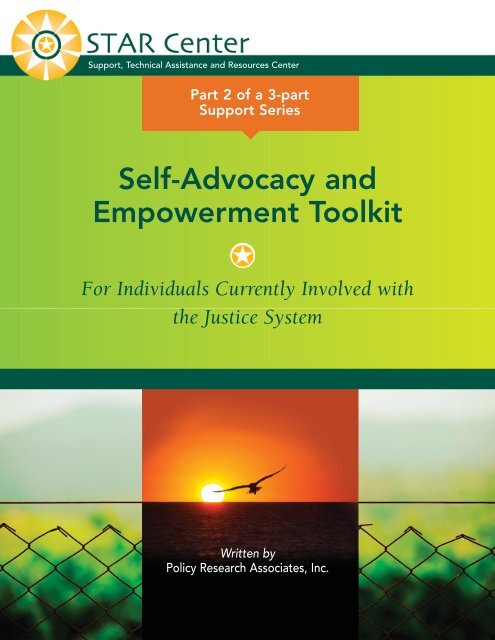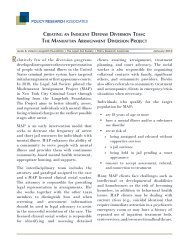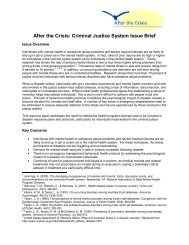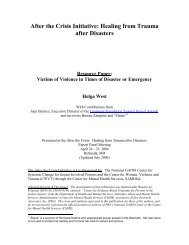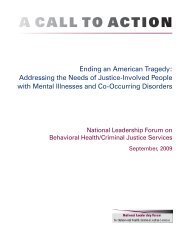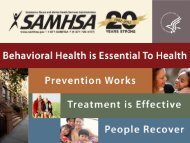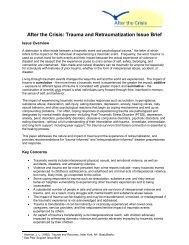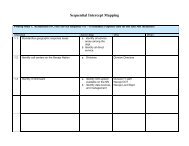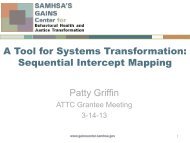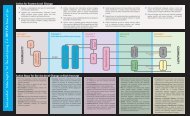Self-Advocacy and Empowerment Toolkit - STAR Center
Self-Advocacy and Empowerment Toolkit - STAR Center
Self-Advocacy and Empowerment Toolkit - STAR Center
You also want an ePaper? Increase the reach of your titles
YUMPU automatically turns print PDFs into web optimized ePapers that Google loves.
Support, Technical Assistance <strong>and</strong> Resources <strong>Center</strong><br />
Part 2 of a 3-part<br />
Support Series<br />
<strong>Self</strong>-<strong>Advocacy</strong> <strong>and</strong><br />
<strong>Empowerment</strong> <strong>Toolkit</strong><br />
For Individuals Currently Involved with<br />
the Justice System<br />
Written by<br />
Policy Research Associates, Inc.
Copyright 2012<br />
The National Alliance on Mental Illness (NAMI)<br />
3803 N. Fairfax Dr., Suite 100, Arlington VA 22203<br />
www.nami.org<br />
HelpLine: (800) 950-NAMI (6264)<br />
Twitter: NAMICommunicate<br />
Facebook: www.facebook.com/officialNAMI<br />
Stock photos used in this publication are not meant to indicate any particular attitude or opinion on the part of<br />
those whose images are being used <strong>and</strong> are not intended to indicate an endorsement by the subjects.<br />
The NAMI <strong>STAR</strong> <strong>Center</strong> is a SAMHSA-funded technical assistance center dedicated to promoting <strong>and</strong> enhancing<br />
recovery, mental health, <strong>and</strong> wellness through information, training, <strong>and</strong> resources on effective self-help <strong>and</strong><br />
multicultural competence <strong>and</strong> social inclusion approaches with a special focus on working with underserved<br />
communities.<br />
www.consumerstar.org<br />
www.facebook.com/pages/NAMI-<strong>STAR</strong>-<strong>Center</strong><br />
www.twitter.com/namistarcenter<br />
The <strong>STAR</strong> <strong>Center</strong> gratefully acknowledges SAMHSA as the funding source<br />
for the <strong>STAR</strong> <strong>Center</strong>’s work <strong>and</strong> activities.<br />
Please visit SAMHSA/CMHS at www.samhsa.gov for many helpful resources,<br />
self-help tools, guides <strong>and</strong> links.<br />
The views <strong>and</strong> opinions presented in this document do not necessarily reflect those of SAMHSA or<br />
the U.S. Department of Health <strong>and</strong> Human Services <strong>and</strong> should not be construed as such.<br />
NAMI’s <strong>STAR</strong> <strong>Center</strong> would like to acknowledge Policy<br />
Research Associates (PRA), operators of SAMHSA’s GAINS<br />
<strong>Center</strong>, <strong>and</strong> the following PRA/GAINS <strong>Center</strong> staff who<br />
authored <strong>and</strong> edited this publication:<br />
LaVerne D. Miller, JD<br />
Latrease Moore, MS<br />
Chanson D. Noether, MA<br />
Matthew Canuteson<br />
Samantha Califano, MS<br />
<strong>STAR</strong> <strong>Center</strong> Staff:<br />
Philip Qualo, J.D.<br />
Program Manager<br />
Stephen Kiosk, M.Div., LPC<br />
Director
Support, Technical Assistance <strong>and</strong> Resources <strong>Center</strong><br />
Part 2 of a 3-part<br />
Support Series<br />
<strong>Self</strong>-<strong>Advocacy</strong> <strong>and</strong><br />
<strong>Empowerment</strong> <strong>Toolkit</strong><br />
For Individuals Currently Involved with<br />
the Justice System<br />
Written by<br />
Policy Research Associates, Inc.
The Journey<br />
Yearning for…searching for…<strong>and</strong> asking why<br />
The struggle to find the answers ran wild.<br />
Then I stopped <strong>and</strong> asked <strong>and</strong> then I heard…I am here.<br />
I have always been here <strong>and</strong> I will always take care of you.<br />
For so long what I have searched for I found…<br />
Hope<br />
This small word with such enormous meaning…<br />
Has been the light that guides me on my journey of<br />
Acceptance<br />
Forgiveness<br />
Healing <strong>and</strong>…<br />
Recovery<br />
By Tracy C. Love<br />
Published with Permission from the Author<br />
Acknowledgements<br />
Each recovery journey begins with just one step <strong>and</strong> we hope Learning About Us, Learning to Help Us:<br />
Supporting People with Psychiatric Disabilities in the Criminal Justice System will help you assist people as<br />
they begin <strong>and</strong> progress through their recovery journeys. Developing this guide was truly a collaborative<br />
effort <strong>and</strong> we were driven throughout the process by the conversations we had with the consumers who<br />
played an indispensable role in its development.<br />
Whether it was someone experiencing his or her first contact with the police or someone looking for<br />
employment upon release from a long period of incarceration, their strength <strong>and</strong> optimism truly inspired<br />
this guide’s creation. Most importantly, the consumers who provided input made us even more aware of<br />
the types of resources <strong>and</strong> supports that are the most helpful to people in their recovery processes.<br />
We would like to extend our heartfelt thanks to the dozens of justice-involved consumers who shared their<br />
recovery journeys with us. They shared their challenges <strong>and</strong> successes in an effort to ensure that this guide<br />
was developed by people who know the most about the true predicament of justice-involved consumers<br />
in our country consumers themselves.<br />
For this project, members of this largely invisible community chose to break their silence to bring a<br />
message of hope to others, many times sharing painful experiences. In so doing, they picked hope over<br />
fear, success over failure <strong>and</strong> forgiveness over anger.<br />
Lastly, we thank the members of the Advisory Committee for providing invaluable support <strong>and</strong> guidance<br />
for this project; without their leadership, none of this would have been possible.
Table of Contents<br />
<strong>Self</strong>-help<br />
Introduction<br />
<strong>and</strong> Peer<br />
................................................................<br />
Support Services<br />
2<br />
4<br />
Why Assess Your Program’s Cultural Competency ...................................... 2<br />
<strong>Self</strong>-exploration Basic Definitions Tools ............................................................. <strong>and</strong> Recovery Tools 25<br />
How to Use This Tool .......................................................... 3<br />
Wellness How Tools This Tool Was Evaluated .................................................... 46<br />
Alternative Focus Area Approaches 1: Administration, to Wellness Policies <strong>and</strong> Guidelines<br />
8<br />
Why Does This Matter ........................................................ 5<br />
Community Where Connections: Do We Look Housing, .......................................................... Employment/ Education, Voting Rights 59<br />
What Are Next Steps for Our Action Plan ......................................... 6<br />
Underst<strong>and</strong>ing the Behavioral Health System 10<br />
Bright Idea! ................................................................ 7<br />
Sequential Try This! Intercept ................................................................... Model 11 7<br />
Focus Area 2: Peer Providers <strong>and</strong> Group Leaders<br />
Conclusion 13<br />
Why Does This Matter ........................................................ 8<br />
Where Do We Look .......................................................... 8<br />
What Are Next Steps for Our Action Plan ......................................... 9<br />
Bright Idea! ................................................................10<br />
Try This! ...................................................................10<br />
Focus Area 3: Services <strong>and</strong> Support<br />
Why Does This Matter ........................................................11<br />
Where Do We Look ..........................................................11<br />
What Are Next Steps for Our Action Plan .........................................13<br />
Bright Idea! ................................................................13<br />
Try This! ...................................................................14<br />
Focus Area 4: Program <strong>and</strong> Group Environment<br />
Why Does This Matter ........................................................15<br />
Where Do We Look ..........................................................15<br />
What Are Next Steps for Our Action Plan .........................................16<br />
Bright Idea! ................................................................17<br />
Try This! ...................................................................17<br />
Focus Area 5: Communication <strong>and</strong> Language Capacity<br />
Why Does This Matter ........................................................18<br />
Where Do We Look ..........................................................18<br />
What Are Next Steps for Our Action Plan .........................................19<br />
Bright Idea! ................................................................20<br />
Try This! ...................................................................20<br />
Cultural Competency Assessment Ratings .............................................21<br />
Common Challenges in Developing Competency ........................................22<br />
Recognizing Culturally Competent Peer Supporters. .....................................22<br />
Our Diversity Action Plan .........................................................23<br />
Diversity Survey for Peer-run Group Program Participants. ................................24<br />
Diversity Survey for Peer-run Group Program Leaders ....................................25<br />
Appendix: Resources..............................................................27<br />
Additional Readings ..........................................................29<br />
Learn About Your Community Using U.S. Census Bureau Information. .....................29<br />
Notes ....................................................................30<br />
Table of Contents 1
The <strong>Self</strong>-advocacy <strong>and</strong> <strong>Empowerment</strong> <strong>Toolkit</strong> identifies<br />
resources <strong>and</strong> strategies to guide you, its<br />
readers―individuals with behavioral health issues <strong>and</strong><br />
past or current contact with the criminal justice<br />
system―in achieving personal recovery goals. The <strong>Toolkit</strong><br />
responds to the expressed need of justice-involved<br />
people with behavioral health issues for additional<br />
resources to assist them in making informed decisions<br />
about their futures in a manner that accounts for their<br />
unique challenges. Although all consumers experience<br />
challenges, justice-involved consumers face a special set<br />
of challenges <strong>and</strong> barriers in their recovery journeys.<br />
These tools were designed to help you overcome these<br />
challenges <strong>and</strong> allow you to enjoy all the opportunities<br />
<strong>and</strong> benefits of a full life in the community.<br />
This toolkit discusses services <strong>and</strong> supports <strong>and</strong> provides<br />
you with contact information to help you access them.<br />
Most importantly, these resources can connect you with<br />
something necessary to move forward with your life –<br />
hope. Hope is one of the keys to being able to overcome<br />
life’s challenges.<br />
What is Recovery<br />
Recovery is a term used frequently throughout this<br />
guide, in the Consumer <strong>Toolkit</strong> <strong>and</strong> in the Personal<br />
Narratives. You have probably heard this term in the<br />
context of stopping the use of drugs or alcohol or<br />
getting better from an illness or an injury. In December<br />
2011, SAMHSA released a working definition of<br />
recovery <strong>and</strong> a set of guiding principles. This definition<br />
was the result of a comprehensive process that began<br />
with an August 2010 Dialogue Meeting <strong>and</strong> ended<br />
with a formal public engagement process in August<br />
2011. At the time SAMHSA released the working<br />
definition, SAMHSA indicated that they would<br />
continue dialogue to refine the definition <strong>and</strong><br />
principles <strong>and</strong> based on additional stakeholder input,<br />
SAMHSA then issued a slightly revised definition.<br />
The revised definition is below.<br />
Recovery from Mental Disorders <strong>and</strong>/or Substance<br />
Use Disorders: A process of change through which<br />
individuals improve their health <strong>and</strong> wellness, live a<br />
self-directed life, <strong>and</strong> strive to reach their full potential.<br />
Four major dimensions that support a life in recovery:<br />
• Health: overcoming or managing one’s disease(s)<br />
or symptoms—for example, abstaining from use of<br />
alcohol, illicit drugs, <strong>and</strong> non-prescribed<br />
medications if one has an addiction problem—<strong>and</strong><br />
“I did not use my past as an excuse to fail; I<br />
used it as a source of strength <strong>and</strong> truth to move<br />
me forward. I learned to love again; first myself<br />
<strong>and</strong> then others. I learned to forgive, it set me<br />
free.”<br />
—David F.<br />
for everyone in recovery, making informed, healthy<br />
choices that support physical <strong>and</strong> emotional<br />
wellbeing.<br />
• Home: a stable <strong>and</strong> safe place to live;<br />
• Purpose: meaningful daily activities, such as a job,<br />
school, volunteerism, family caretaking, or creative<br />
endeavors, <strong>and</strong> the independence, income <strong>and</strong><br />
resources to participate in society; <strong>and</strong><br />
• Community: relationships <strong>and</strong> social networks<br />
that provide support, friendship, love, <strong>and</strong> hope.<br />
Guiding Principles of Recovery<br />
Recovery emerges from hope: The belief that<br />
recovery is real provides the essential <strong>and</strong> motivating<br />
message of a better future – that people can <strong>and</strong> do<br />
overcome the internal <strong>and</strong> external challenges,<br />
barriers, <strong>and</strong> obstacles that confront them. Hope is<br />
internalized <strong>and</strong> can be fostered by peers, families,<br />
providers, allies, <strong>and</strong> others. Hope is the catalyst of the<br />
recovery process.<br />
Recovery is person-driven: <strong>Self</strong>-determination <strong>and</strong><br />
self-direction are the foundations for recovery as<br />
individuals define their own life goals <strong>and</strong> design their<br />
unique path(s) towards those goals. Individuals<br />
optimize their autonomy <strong>and</strong> independence to the<br />
greatest extent possible by leading, controlling, <strong>and</strong><br />
exercising choice over the services <strong>and</strong> supports that<br />
assist their recovery <strong>and</strong> resilience. In so doing, they<br />
are empowered <strong>and</strong> provided the resources to make<br />
informed decisions, initiate recovery, build on their<br />
strengths, <strong>and</strong> gain or regain control over their lives.<br />
Recovery occurs via many pathways: Individuals are<br />
unique with distinct needs, strengths, preferences,<br />
goals, culture, <strong>and</strong> backgrounds including trauma<br />
experiences that affect <strong>and</strong> determine their pathway(s)<br />
to recovery. Recovery is built on the multiple capacities,<br />
strengths, talents, coping abilities, resources, <strong>and</strong><br />
inherent value of each individual. Recovery pathways<br />
are highly personalized. They may include professional<br />
clinical treatment; use of medications; support from<br />
families <strong>and</strong> in schools; faith-based approaches; peer<br />
support; <strong>and</strong> other approaches. Recovery is non-linear,<br />
2 <strong>Self</strong>-<strong>Advocacy</strong> <strong>and</strong> <strong>Empowerment</strong> <strong>Toolkit</strong>
“I’m stronger now…when you heal you become<br />
a different person. Having an illness doesn’t<br />
define who you are. It’s going to take a lot of<br />
work, a lot of voices <strong>and</strong> a lot of healing. The<br />
system is healing.”<br />
—Tracy L.<br />
characterized by continual growth <strong>and</strong> improved<br />
functioning that may involve setbacks. Because<br />
setbacks are a natural, though not inevitable, part of<br />
the recovery process, it is essential to foster resilience<br />
for all individuals <strong>and</strong> families. Abstinence from the use<br />
of alcohol, illicit drugs, <strong>and</strong> non-prescribed<br />
medications is the goal for those with addictions. Use<br />
of tobacco <strong>and</strong> non-prescribed or illicit drugs is not<br />
safe for anyone. In some cases, recovery pathways can<br />
be enabled by creating a supportive environment. This<br />
is especially true for children, who may not have the<br />
legal or developmental capacity to set their own<br />
course.<br />
Recovery is holistic: Recovery encompasses an<br />
individual’s whole life, including mind, body, spirit, <strong>and</strong><br />
community. This includes addressing: self-care<br />
practices, family, housing, employment, education,<br />
clinical treatment for mental disorders <strong>and</strong> substance<br />
use disorders, services <strong>and</strong> supports, primary<br />
healthcare, dental care, complementary <strong>and</strong> alternative<br />
services, faith, spirituality, creativity, social networks,<br />
transportation, <strong>and</strong> community participation. The array<br />
of services <strong>and</strong> supports available should be integrated<br />
<strong>and</strong> coordinated.<br />
Recovery is supported by peers <strong>and</strong> allies: Mutual<br />
support <strong>and</strong> mutual aid groups, including the sharing of<br />
experiential knowledge <strong>and</strong> skills, as well as social<br />
learning, play an invaluable role in recovery. Peers<br />
encourage <strong>and</strong> engage other peers <strong>and</strong> provide each<br />
other with a vital sense of belonging, supportive<br />
relationships, valued roles, <strong>and</strong> community. Through<br />
helping others <strong>and</strong> giving back to the community, one<br />
helps one’s self. Peer-operated supports <strong>and</strong> services<br />
provide important resources to assist people along their<br />
journeys of recovery <strong>and</strong> wellness. Professionals can<br />
also play an important role in the recovery process by<br />
providing clinical treatment <strong>and</strong> other services that<br />
support individuals in their chosen recovery paths.<br />
While peers <strong>and</strong> allies play an important role for many in<br />
recovery, their role for children <strong>and</strong> youth may be slightly<br />
different. Peer supports for families are very important<br />
for children with behavioral health problems <strong>and</strong> can<br />
also play a supportive role for youth in recovery.<br />
Recovery is supported through relationship <strong>and</strong><br />
social networks: An important factor in the recovery<br />
process is the presence <strong>and</strong> involvement of people<br />
who believe in the person’s ability to recover; who offer<br />
hope, support, <strong>and</strong> encouragement; <strong>and</strong> who also<br />
suggest strategies <strong>and</strong> resources for change. Family<br />
members, peers, providers, faith groups, community<br />
members, <strong>and</strong> other allies form vital support networks.<br />
Through these relationships, people leave unhealthy<br />
<strong>and</strong>/or unfulfilling life roles behind <strong>and</strong> engage in new<br />
roles (e.g., partner, caregiver, friend, student,<br />
employee) that lead to a greater sense of belonging,<br />
personhood, empowerment, autonomy, social<br />
inclusion, <strong>and</strong> community participation.<br />
Recovery is culturally-based <strong>and</strong> influenced: Culture<br />
<strong>and</strong> cultural background in all of its diverse<br />
representations including values, traditions, <strong>and</strong> beliefs<br />
are keys in determining a person’s journey <strong>and</strong> unique<br />
pathway to recovery. Services should be culturally<br />
grounded, attuned, sensitive, congruent, <strong>and</strong><br />
competent, as well as personalized to meet each<br />
individual’s unique needs.<br />
Recovery is supported by addressing trauma: The<br />
experience of trauma (such as physical or sexual abuse,<br />
domestic violence, war, disaster, <strong>and</strong> others) is often a<br />
precursor to or associated with alcohol <strong>and</strong> drug use,<br />
mental health problems, <strong>and</strong> related issues. Services<br />
<strong>and</strong> supports should be trauma-informed to foster<br />
safety (physical <strong>and</strong> emotional) <strong>and</strong> trust, as well as<br />
promote choice, empowerment, <strong>and</strong> collaboration.<br />
“I got involved with a wonderful support<br />
group with other mothers who were on<br />
parole. I learned that it was a process. I<br />
could work <strong>and</strong> move forward. I had a<br />
support network of peers <strong>and</strong> providers<br />
to help me through this process. They<br />
met me where I was at <strong>and</strong> did not<br />
impose st<strong>and</strong>ards on me but held me<br />
accountable for my actions. They helped<br />
me reconnect with my family.”<br />
— Jeanette B.<br />
For Individuals Currently Involved with the Justice System 3
Recovery involves individual, family, <strong>and</strong> community<br />
strengths <strong>and</strong> responsibility: Individuals, families, <strong>and</strong><br />
communities have strengths <strong>and</strong> resources that serve<br />
as a foundation for recovery. In addition, individuals<br />
have a personal responsibility for their own self-care<br />
<strong>and</strong> journeys of recovery. Individuals should be<br />
supported in speaking for themselves. Families <strong>and</strong><br />
significant others have responsibilities to support their<br />
loved ones, especially for children <strong>and</strong> youth in<br />
recovery. Communities have responsibilities to provide<br />
opportunities <strong>and</strong> resources to address discrimination<br />
<strong>and</strong> to foster social inclusion <strong>and</strong> recovery. Individuals<br />
in recovery also have a social responsibility <strong>and</strong> should<br />
have the ability to join with peers to speak collectively<br />
about their strengths, needs, wants, desires, <strong>and</strong><br />
aspirations.<br />
Recovery is based on respect: Community, systems,<br />
<strong>and</strong> societal acceptance <strong>and</strong> appreciation for people<br />
affected by mental health <strong>and</strong> substance use problems<br />
—including protecting their rights <strong>and</strong> eliminating<br />
discrimination—are crucial in achieving recovery.<br />
There is a need to acknowledge that taking steps<br />
towards recovery may require great courage. <strong>Self</strong>acceptance,<br />
developing a positive <strong>and</strong> meaningful<br />
sense of identity, <strong>and</strong> regaining belief in one’s self are<br />
particularly important. 1<br />
Hope<br />
Reposibility<br />
Components of Recovery<br />
Person-driven<br />
Addresses Trauma<br />
Strengths<br />
Community<br />
“The best part about my journal was when I<br />
looked back at what I had written, months <strong>and</strong><br />
years later. I was able to gain even more strength<br />
from reading how I was able to get through life’s<br />
trials <strong>and</strong> tribulations...it gave me hope to use<br />
when new challenges arose later in my recovery.”<br />
— Matt C.<br />
<strong>Self</strong>-help <strong>and</strong> Peer<br />
Support Services<br />
<strong>Self</strong>-help Groups<br />
Consumers have developed many self-help programs<br />
where people provide support to each other in<br />
recovery. A number of well-known self-help groups <strong>and</strong><br />
organizations in your community may assist your<br />
recovery process. Consumer self-help groups <strong>and</strong> 12-<br />
step programs, such as Alcoholics Anonymous <strong>and</strong><br />
Narcotics Anonymous, are founded on the principle<br />
that people receive the best support from others who<br />
are overcoming similar challenges. It is important that<br />
you find self-help groups that welcome you <strong>and</strong> that<br />
meet your individual needs. These programs <strong>and</strong><br />
groups are often a good place to begin the transition<br />
back into your community following incarceration.<br />
You may be looking for a self-help group for parents or<br />
you may be looking for a self-help group to help you<br />
remain “clean <strong>and</strong> sober”—most communities have<br />
many different groups <strong>and</strong> we suggest that you try out<br />
a few before deciding which one(s) you want to attend<br />
regularly.<br />
Nothing prevents you from attending more than one<br />
support group at a time. If you are looking to establish<br />
new friendships, self-help groups are a wonderful way<br />
to meet new people <strong>and</strong> to socialize.<br />
Respect<br />
Individual<br />
Family<br />
These groups complement other forms of treatment<br />
you may be receiving. To find self-help groups <strong>and</strong><br />
peer support services in your area, contact:<br />
Peers<br />
Allies<br />
Relationships<br />
<strong>and</strong><br />
Social Networks<br />
Culture<br />
Holistic<br />
Alcoholics Anonymous<br />
A.A. World Services, Inc<br />
P.O. Box 459<br />
New York, N.Y. 10163<br />
(212) 870-3400<br />
http://www.aa.org<br />
1Substance Abuse <strong>and</strong> Mental Health Services Administration. (2011). SAMHSA’s Working Definition of Recovery from Mental Disorders<br />
<strong>and</strong>/or Substance Use Disorders. Rockville, Md.: Author.<br />
4 <strong>Self</strong>-<strong>Advocacy</strong> <strong>and</strong> <strong>Empowerment</strong> <strong>Toolkit</strong>
“I am now empowered to learn about trauma,<br />
PTSD, depression <strong>and</strong> all the mental health<br />
things that would help me <strong>and</strong> help me…<br />
advocate for myself. This journey was the<br />
hardest <strong>and</strong> probably still is the hardest thing in<br />
my life. I have gotten training on WRAP Plans<br />
<strong>and</strong> I worked with others that have similar<br />
trauma experiences just like me.”<br />
— Ruben B.<br />
Narcotics Anonymous<br />
P.O. Box 9999<br />
Van Nuys, Calif. 91409<br />
(818) 773-9999<br />
http://www.na.org<br />
Peer-to-Peer Organizations<br />
National Mental Health Consumers’ <strong>Self</strong>-Help<br />
Clearinghouse<br />
1211 Chestnut Street, Suite 1207<br />
Philadelphia, Pa. 19107<br />
(800) 553-4539<br />
http://www.mhselfhelp.org<br />
SAMHSA’s Resource <strong>Center</strong> to Promote<br />
Acceptance, Dignity <strong>and</strong> Social Inclusion Associated<br />
with Mental Health (ADS <strong>Center</strong>)<br />
4350 East West Highway, Suite 1100<br />
Bethesda, Md. 20814<br />
(800) 540-0320<br />
http://promoteacceptance.samhsa.gov<br />
Warm Lines<br />
Consumer-operated warm lines are phone numbers<br />
people can call to receive peer support over the<br />
phone. Warm lines are available in many communities<br />
to assist individuals who are unable to travel to peer<br />
support groups or are in need of immediate support.<br />
Warm line operators receive peer support training <strong>and</strong><br />
ongoing supervision by the organization operating the<br />
warm line. Most warm lines have toll-free numbers <strong>and</strong><br />
many operate 24 hours a day. To find out more<br />
information about warm lines <strong>and</strong> to locate one in your<br />
community visit http://buzz.freeshell.org/wlines/ or<br />
contact:<br />
National <strong>Empowerment</strong> <strong>Center</strong><br />
599 Canal Street<br />
Lawrence, Mass. 01840<br />
(800) 769-3728<br />
http://www.power2u.org<br />
National Mental Health Consumers’<br />
<strong>Self</strong>-Help Clearinghouse<br />
1211 Chestnut Street, Suite 1207<br />
Philadelphia, Pa. 19107<br />
(800) 553-4539<br />
E-mail: info@mhselfhelp.org<br />
http://www.mhselfhelp.org<br />
<strong>Self</strong>-exploration Tools <strong>and</strong><br />
Recovery Tools<br />
Each year thous<strong>and</strong>s of people with mental health<br />
issues come into contact with the criminal justice<br />
system. Jails <strong>and</strong> prisons have cultures of their own.<br />
The same behaviors <strong>and</strong> attitudes you may have<br />
developed in jail or prison to make it easier to fit in <strong>and</strong><br />
feel protected may become major obstacles to your<br />
recovery. We would like to support you in finding new<br />
ways of thinking about your life. Below is a list of<br />
resources that can be used by you to help support you<br />
in your recovery journey.<br />
Personal Journals<br />
Journals are a good way to begin the process of talking<br />
about yourself, your feelings, your past, your needs<br />
<strong>and</strong> your dreams <strong>and</strong> aspirations. Keeping a personal<br />
journal can help you experiment with new ways of<br />
dealing with the problems or issues you want to<br />
confront <strong>and</strong> overcome during your recovery journey.<br />
You can chart your feelings about trying new behaviors<br />
<strong>and</strong> the benefits these new behaviors have on recovery.<br />
By keeping a journal <strong>and</strong> charting the ways that you<br />
were able to get through tough times in your life, you<br />
will be able to look back at these tough times with a<br />
clear view of the ways you were able to overcome<br />
challenges, while keeping consistent with your path to<br />
recovery. This helps you underst<strong>and</strong> that, while some<br />
time periods may be harder than others, you can still<br />
overcome <strong>and</strong> get through anything.<br />
For Individuals Currently Involved with the Justice System 5
WRAP ®<br />
The Wellness Recovery Action Plan ® (WRAP ® ), was<br />
developed to empower consumers to take personal<br />
responsibility for maintaining their personal wellness<br />
<strong>and</strong> recovery. This innovative evidence-based practice<br />
can be used to identify your own wellness tools <strong>and</strong><br />
how to use them when you are feeling unwell or<br />
unsafe. 2 Increasingly, WRAP ® is being used by justiceinvolved<br />
consumers. Research has found that WRAP ® is<br />
very helpful in helping people avoid crisis <strong>and</strong> relapse.<br />
If you are interested in developing your own WRAP ® or<br />
finding a WRAP ® facilitator in your community, contact<br />
the Copel<strong>and</strong> <strong>Center</strong>:<br />
Mary Ellen Copel<strong>and</strong><br />
Mental Health Recovery <strong>and</strong> WRAP ®<br />
PO Box 301<br />
W. Dummerston, Vt. 05357<br />
(802) 254-2092<br />
www.mentalhealthrecovery.com<br />
Pathways to Recovery: A Strengths<br />
Recovery <strong>Self</strong>-help Workbook<br />
The Pathways to Recovery self-help workbook was<br />
created by staff at the University of Kansas School of<br />
Social Welfare together with an advisory group of peer<br />
providers, directors of consumer-run organizations <strong>and</strong><br />
other progressive mental health providers. The lead<br />
author of Pathways to Recovery is Priscilla Ridgway.<br />
This tool can help you set goals <strong>and</strong> address difficult<br />
aspects of recovery, such as self-stigma <strong>and</strong> the impact<br />
of discrimination. 3<br />
For a copy of the Pathways to Recovery: A Strengths<br />
Recovery <strong>Self</strong>-Help Workbook contact:<br />
Office of Mental Health Research <strong>and</strong> Training<br />
KU School of Social Welfare<br />
Twente Hall<br />
1545 Lilac L<strong>and</strong><br />
Lawrence, Kan. 66044<br />
(785) 864-4720<br />
http://www.socwel.ku.edu/mentalhealth/projects/valu<br />
e/pathways/workbook.shtml<br />
The South Carolina Share Recovery<br />
Planner<br />
The South Carolina Share Recovery Planner is a quick<br />
<strong>and</strong> easy workbook that can help you think about goals<br />
<strong>and</strong> areas to focus on. It addresses change, positive<br />
self-talk, physical health, emotional/mental wellness,<br />
stress, substance use, living space, money, down time,<br />
employment/volunteer work, education/training,<br />
relationships, legal issues, spirituality <strong>and</strong> daily routine.<br />
The Planner is available in both English <strong>and</strong> Spanish. 4<br />
To access a copy of the South Carolina Share Recovery<br />
Planner, contact:<br />
South Carolina Share<br />
427 Meeting Street<br />
West Columbia, S.C. 29169<br />
(800) 832-8023<br />
http://www.scshare.com/about.html<br />
Wellness Tools<br />
Over the past few years there has been a growing<br />
recognition that mental health is related to overall<br />
health <strong>and</strong> wellness. This guide provides an overview<br />
of wellness <strong>and</strong> ways that you can take ownership for<br />
your overall well-being. Wellness services <strong>and</strong> activities<br />
are often available in your community for little to no<br />
cost. Many wellness activities can be pursued<br />
individually, such as a walk on the beach or at a nature<br />
center at the end of a long day. To learn more about<br />
the services <strong>and</strong> activities offered in your community,<br />
contact your local chamber of commerce. Below are<br />
several tools you can use to take control of your overall<br />
health <strong>and</strong> wellness. Four “categories” of wellness are<br />
portrayed in the diagram below; discussed here are<br />
physical, spiritual <strong>and</strong> financial wellness.<br />
Physical<br />
Physical wellness is as important as mental wellness<br />
<strong>and</strong> poor physical health can negatively impact mental<br />
health. There are three basic components to physical<br />
wellness: prevention, recovery <strong>and</strong> maintenance. Begin<br />
by setting a wellness goal. Some examples of physical<br />
wellness are safely taking medications, engaging in<br />
2 Copel<strong>and</strong>, M.E. (2010). Wellness Recovery Action Plan®. Retrieved July 21, 2010, from http://mentalhealthrecovery.com/aboutwrap.php.<br />
3 University of Kansas, School of Social Welfare. (2003). Pathways to recovery: A strengths recovery self-help workbook.<br />
Retrieved July 21, 2010, from http://www.socwel.ku.edu/mentalhealth/projects/value/pathways/workbook.shtml.<br />
4 South Carolina SHARE. (2008). Recovery planner. Retrieved July 21, 2010, from http://www.scshare.com/recovery_programs.html<br />
6 <strong>Self</strong>-<strong>Advocacy</strong> <strong>and</strong> <strong>Empowerment</strong> <strong>Toolkit</strong>
Financial<br />
Mental<br />
Wellness<br />
Physical<br />
Spiritual<br />
Spiritual wellness is a personal matter involving values<br />
<strong>and</strong> beliefs that provide a purpose in our lives. While<br />
different individuals may have different views of what<br />
spirituality is, it is generally considered to be the search<br />
for meaning <strong>and</strong> purpose in our recovery processes. It<br />
is important for everyone to explore what they believe<br />
is their own sense of meaning <strong>and</strong> purpose. Below are<br />
four ways to explore your values <strong>and</strong> beliefs.<br />
Spiritual<br />
1. Make time in your day to relax.<br />
2. Make time for meditation <strong>and</strong>/or prayer.<br />
3. Reflect on your values. Do your values guide your<br />
decisions <strong>and</strong> actions<br />
4. Reflect on others’ values. Do you accept the views<br />
of others<br />
physical activities, eating a nutritious diet, maintaining<br />
healthy sleep habits <strong>and</strong> connecting with nature. Chart<br />
your daily activities; start slowly <strong>and</strong> work your way up<br />
to a lifelong behavioral change. Charting how you feel<br />
after physical activities <strong>and</strong> how you feel after a full<br />
night’s sleep will help you underst<strong>and</strong> what your body<br />
needs to feel healthy. For more information on the<br />
importance of mental <strong>and</strong> physical wellness contact:<br />
Physical Activity Guidelines for Americans<br />
<strong>Center</strong>s for Disease Control <strong>and</strong> Prevention<br />
1600 Clifton Rd.<br />
Atlanta, Ga. 30333<br />
http://www.cdc.gov/physicalactivity/everyone/guidelin<br />
es/index.html<br />
USDA <strong>Center</strong> for Nutrition Policy <strong>and</strong> Promotion<br />
3101 Park <strong>Center</strong> Drive<br />
Alex<strong>and</strong>ria, Va. 22302-1594<br />
(888) 779-7264<br />
ChooseMyPlate.gov<br />
SAMHSA 10 x 10 Wellness Campaign<br />
2121 K Street, NW, Suite 300<br />
Washington, D.C. 20037<br />
10x10@samhsa.hhs.govhttp://www.promoteacceptanc<br />
e.samhsa.gov/10by10<br />
As we discussed in a previous section, journaling can<br />
be a good way to reflect on your values <strong>and</strong> on others’<br />
values. To learn more about spiritual growth <strong>and</strong> its<br />
impact on your recovery, contact NAMI’s <strong>STAR</strong> <strong>Center</strong>:<br />
NAMI <strong>STAR</strong> <strong>Center</strong><br />
3803 N. Fairfax Dr., Suite 100<br />
Arlington, Va. 22203<br />
(866) 537-7827<br />
star@nami.org<br />
http://www.consumerstar.org<br />
Financial<br />
Finances are one of the leading stressors faced by<br />
justice-involved consumers. Financial problems can<br />
impact housing, employment <strong>and</strong> education.<br />
Confronting the challenges related to your finances is<br />
important because it is difficult to focus on your<br />
recovery when you do not have a source of income,<br />
medical coverage or a place to live. You may be<br />
eligible for disability benefits <strong>and</strong> other benefits that<br />
can provide a safety net during your recovery process.<br />
Obtaining many of these benefits can be timeconsuming<br />
<strong>and</strong> frustrating. Many justice-involved<br />
consumers ab<strong>and</strong>on efforts to obtain benefits because<br />
of the time <strong>and</strong> energy involved in applying for them.<br />
Although employment is an important part of the<br />
recovery process <strong>and</strong> employment may be one of your<br />
recovery goals, applying for <strong>and</strong> receiving these<br />
For Individuals Currently Involved with the Justice System 7
enefits do not prevent you from pursuing<br />
employment. We recommend that you carefully<br />
explore the options available to you <strong>and</strong> then make<br />
informed choices about how you want to move<br />
forward.<br />
Social Security Benefits<br />
Social Security disability benefits can help individuals<br />
obtain housing, treatment <strong>and</strong> other services. Contact<br />
your local Social Security Administration field office or<br />
the Social Security Administration for information <strong>and</strong><br />
resources related to Social Security disability benefits.<br />
Social Security Administration<br />
Office of Public Inquires<br />
Windsor Park Building<br />
6401 Security Blvd.<br />
Baltimore, Md. 21235<br />
(800) 772-1213<br />
www.ssa.gov<br />
Annual Credit Report<br />
Many justice-involved consumers find they have<br />
difficulty obtaining credit or approval for housing or<br />
employment. Many of these difficulties can be traced<br />
to negative information contained in credit reports. In<br />
general, a credit report contains information about<br />
your previous credit history, as well as legal judgments.<br />
A judgment is obtained where legal action is taken by<br />
a “creditor,” such as a l<strong>and</strong>lord, bank or credit card<br />
company, seeking compensation <strong>and</strong> the creditor is<br />
awarded money (the judgment) because the creditor<br />
either wins the court case or the defendant fails to<br />
appear in court. We are finding in many instances that<br />
justice-involved consumers are either unaware they are<br />
being sued or simply ignore notices summoning them<br />
to court. These judgments do not go away <strong>and</strong> most<br />
remain on your credit report for at least seven years.<br />
Consequently, it is important to be proactive <strong>and</strong><br />
obtain a copy of your credit report <strong>and</strong> carefully review<br />
it. Once you review your credit report, you can exercise<br />
your right to dispute information contained in the<br />
report. The reporting agencies are required by law to<br />
investigate your claim <strong>and</strong> provide the outcome of<br />
their investigation to you.<br />
My Vocational Rehabilitation Counselor told me<br />
to “stop beating myself up.” She helped me<br />
improve my self-esteem. I applied for a Peer<br />
<strong>Advocacy</strong> position in hospital <strong>and</strong> I got the job.”<br />
The Federal Trade Commission has set up a website<br />
where you can request to view your free credit report<br />
from the three largest nationwide credit reporting<br />
companies <strong>and</strong> file your dispute electronically or you<br />
can request by phone or by mail a copy of your free<br />
report. You can obtain a free copy of your current credit<br />
report annually. This allows you to keep track of your<br />
current credit history. To obtain a copy of your free<br />
credit report contact:<br />
Annual Report Request Services<br />
P.O. Box 105281<br />
Atlanta, Ga. 30348<br />
(877) 322-8228<br />
https://www.annualcreditreport.com<br />
Alternative Approaches<br />
to Wellness<br />
Many justice-involved consumers successfully use<br />
alternative activities/services/treatments as an<br />
important part of their overall wellness routine.<br />
These alternative approaches often replace or<br />
complement traditional behavioral health services.<br />
Many of these activities/services/treatments may<br />
be provided at no or low cost by local communitybased<br />
organizations or by community-based<br />
volunteers. Below is a small sample of some of the<br />
alternatives you may want to explore. 5<br />
National <strong>Empowerment</strong> <strong>Center</strong><br />
599 Canal Street<br />
Lawrence, Mass. 01840<br />
(800) 769-3728<br />
http://www.power2u.org<br />
— Keisha<br />
5 SAMHSA Health Information Network. (2003). Alternative approaches to mental health care. Retrieved August 31, 2010 from<br />
https://store.samhsa.gov/product/KEN98-0044<br />
8 <strong>Self</strong>-<strong>Advocacy</strong> <strong>and</strong> <strong>Empowerment</strong> <strong>Toolkit</strong>
Aproaches<br />
Spiritual Counseling<br />
Animal Assisted Therapies<br />
Expressive Therapies<br />
Culturally Based Healing Arts<br />
Descriptions<br />
Some individuals seek counseling from pastors, rabbis, priests or<br />
other spiritual advisors.<br />
A therapeutic approach that uses animals as a part of the support<br />
given to people to help them with communication, self esteem <strong>and</strong><br />
other treatment goals.<br />
Art therapy, dance/movement therapy <strong>and</strong> music/sound therapy are<br />
therapeutic approaches that use the arts to support people’s healing<br />
processes<br />
Approaches usually connected to the traditional healing techniques<br />
of certain ethnic or spiritual groups: acupuncture, reiki, yoga <strong>and</strong><br />
talking circles incorporate herbal/natural remedies, nutrition,<br />
exercise <strong>and</strong> medication/prayer to help individuals balance their<br />
spiritual, physical <strong>and</strong> mental “selves.”<br />
National Mental Health Consumers'<br />
<strong>Self</strong>-Help Clearinghouse<br />
1211 Chestnut Street, Suite 1207<br />
Philadelphia, Pa. 19107<br />
(800) 553-4539<br />
info@mhselfhelp.org<br />
http://mhselfhelp.orgCommunity Connections<br />
Community Connections:<br />
Housing, Employment/<br />
Education, Voting Rights<br />
Housing<br />
Involvement with the criminal justice system frequently<br />
leaves individuals facing many challenges around<br />
community connections in housing, employment/<br />
education <strong>and</strong> voting rights.<br />
Supportive housing programs are available nationwide<br />
to ensure that temporary <strong>and</strong> permanent housing<br />
options are available to justice-involved consumers. To<br />
learn more about the housing assistance options in<br />
your community <strong>and</strong> state, contact your local county<br />
behavioral health agency <strong>and</strong>/or the U.S. Department<br />
of Housing <strong>and</strong> Urban Development (HUD):<br />
U.S. Department of Housing <strong>and</strong> Urban Development<br />
451 7th Street S.W.<br />
Washington, D.C. 20410<br />
(202) 708-1112<br />
http://portal.hud.gov/portal/page/portal/HUD/topics/<br />
homelessness/localassist<br />
Employment/Education<br />
Justice-involved consumers are often faced with<br />
obstacles that may prohibit their employment in<br />
particular professions. Through the U.S. Department of<br />
Education, each state provides counseling, evaluation<br />
<strong>and</strong> job placement services. To find a vocational<br />
rehabilitation agency in your state contact:<br />
U.S. Department of Education<br />
State Vocational Rehabilitation Agency<br />
400 Maryl<strong>and</strong> Avenue, S.W.<br />
Washington, D.C. 20202-4760.<br />
http://wdcrobcolp01.ed.gov/Programs/EROD/org_list.<br />
cfmcategory_ID=SVR<br />
The National H.I.R.E Network<br />
236 Massachusetts Ave. NE, Suite 505<br />
Washington, D.C. 20002-4980<br />
(202) 544-5478<br />
http://www.hirenetwork.org<br />
For Individuals Currently Involved with the Justice System 9
Criminal Records<br />
It is important for justice-involved consumers to obtain<br />
an official copy of their “rap sheet.” Rap sheets often<br />
contain inaccurate information <strong>and</strong> it is important for<br />
justice-involved consumers to get an idea of what type<br />
of information a potential employer may see when<br />
conducting a background check. It may be difficult to<br />
revisit the information contained in these records;<br />
however, it is equally important to directly confront it.<br />
Virtually every state has a criminal justice advocacy<br />
agency that can assist justice-involved consumers in<br />
obtaining a rap sheet <strong>and</strong> in resolving any inaccurate<br />
information contained in the record. These services are<br />
usually free.<br />
Similarly, many states have enacted statutes that<br />
eliminate many of the legal barriers that justiceinvolved<br />
consumers may face. Most of these statues<br />
require you to “petition” a court for “relief from civil<br />
disabilities” (the title of this type of action may be<br />
different depending on the state you live in). You can<br />
be proactive in learning about your legal rights <strong>and</strong><br />
responsibilities by contacting the Legal Action <strong>Center</strong><br />
or other legal advocacy organizations in your<br />
community.<br />
The Legal Action <strong>Center</strong> is an advocacy organization<br />
devoted to advocating for the rights of all individuals<br />
who have been involved in the criminal justice system.<br />
They have developed a website that lists advocacy<br />
organizations in each state that assist justice-involved<br />
consumers in obtaining their rap sheets <strong>and</strong> requesting<br />
corrections of inaccuracies <strong>and</strong> provide other types of<br />
support. For more information about accessing your<br />
criminal justice system records <strong>and</strong> the availability of<br />
other resources in your state contact:<br />
Legal Action <strong>Center</strong><br />
225 Varick Street<br />
New York, N.Y. 10014<br />
(800) 223-4044<br />
http://www.lac.org<br />
Voting Rights<br />
In many states, justice-involved individuals are faced<br />
with disenfranchisement laws that prohibit them from<br />
voting due to their histories of justice system<br />
involvement. Unfortunately, many justice-involved<br />
individuals are unaware of the law <strong>and</strong> voting rights<br />
restoration process in their state. Most states restore<br />
justice-involved individuals’ voting rights after a<br />
condition of their sentence is met. For more<br />
information on your state’s voting rights restoration<br />
process contact your local board of elections <strong>and</strong>:<br />
Bazelon <strong>Center</strong> for Mental Health Law<br />
1101 15th Street, NW, Suite 1212<br />
Washington, D.C. 20005<br />
(202) 467-5730<br />
http://www.bazelon.org<br />
National Conference of State Legislatures (NCSL)<br />
Voting Rights Restoration Process<br />
444 North Capitol Street, N.W., Suite 515<br />
Washington, D.C. 20001<br />
(202) 624-5400<br />
http://www.ncsl.org/default.aspxtabid=16529<br />
Underst<strong>and</strong>ing the<br />
Behavioral Health System<br />
The mental health service system is composed of four<br />
sectors that provide both inpatient <strong>and</strong> outpatient<br />
mental health care to adults <strong>and</strong> juveniles. These<br />
sectors are: specialty mental health providers<br />
(psychiatrists, psychologists, psychiatric social workers<br />
<strong>and</strong> psychiatric nurses); general medical/primary care<br />
providers (family physicians, nurse practitioners <strong>and</strong><br />
pediatricians); human services providers (social<br />
welfare, criminal justice <strong>and</strong> religious); <strong>and</strong> voluntary<br />
support networks (self-help groups). 6 It is important to<br />
educate yourself about the options available in your<br />
community before choosing the services you feel are<br />
best for you. For more information on behavioral<br />
health services available in your community contact:<br />
Mental Health America<br />
2000 N. Beauregard Street, 6th Floor<br />
Alex<strong>and</strong>ria, Va. 22311<br />
(800) 969-6642<br />
http://www.nmha.org<br />
6 U.S. Department of Health <strong>and</strong> Human Services. (1999). Mental health: A report of the surgeon general – Chapter 2: The fundamentals of<br />
mental health <strong>and</strong> mental illness. Rockville, Md.: Author.<br />
10 <strong>Self</strong>-<strong>Advocacy</strong> <strong>and</strong> <strong>Empowerment</strong> <strong>Toolkit</strong>
National Alliance on Mental Illness (NAMI)<br />
3803 N. Fairfax Dr., Suite 100<br />
Arlington, Va. 22203<br />
(703) 524-7600<br />
http://nami.org<br />
Sequential Intercept<br />
Model<br />
Since this toolkit was designed to empower you to<br />
overcome challenges <strong>and</strong> to enjoy all the<br />
opportunities of community life, it is important that<br />
you have a solid underst<strong>and</strong>ing of the different<br />
stages of criminal justice system involvement. A<br />
good way to start is to look at the Sequential<br />
Intercept Model. 7<br />
The Sequential Intercept Model is a general<br />
description of the different stages of the criminal<br />
justice process, from first contact with law<br />
enforcement to release from jail or prison. The<br />
model is organized in a way that can help you<br />
identify different parts of the system that might<br />
provide opportunities for you to receive needed<br />
services.<br />
Below you will find a detailed description of the<br />
five intercept points <strong>and</strong> interventions that may be<br />
available in your community:<br />
Law enforcement: police Crisis Intervention<br />
Teams, police-friendly crisis drop-off centers <strong>and</strong><br />
mental health mobile crisis teams;<br />
Initial detention/initial court hearings: Screening<br />
<strong>and</strong> referral processes for identifying defendants<br />
with psychiatric disabilities at jail intake or at a<br />
point prior to initial appearance court hearing, pretrial<br />
jail diversion;<br />
Jails/courts: Pre-sentence jail diversion, specialty<br />
court dockets <strong>and</strong> jail-based services <strong>and</strong> linkages;<br />
Jail <strong>and</strong> prison reentry: Transition planning, linkage<br />
to community-based supports, gap medication<br />
services <strong>and</strong> pre-discharge benefit<br />
enrollment/activation (SSI/SSDI, Medicaid,<br />
Medicare);<br />
Community corrections: Specialized probation<br />
<strong>and</strong> parole caseloads, diversion of probation <strong>and</strong><br />
parole violators <strong>and</strong> use of graduated sanctions for<br />
noncompliance. 8<br />
It is important to underst<strong>and</strong> each stage <strong>and</strong> how<br />
you can best prepare yourself <strong>and</strong> assist advocates,<br />
family members <strong>and</strong> other supporters in ensuring<br />
that you have the best possible opportunity to start<br />
or continue your recovery journey.<br />
Intercept 1: Crisis <strong>and</strong> 911 Calls<br />
Many communities have crisis services available <strong>and</strong> it<br />
is important to be aware of the services available in<br />
your community. You can learn about the services in<br />
your community by contacting your local behavioral<br />
health agency. In some communities, consumeroperated<br />
services provide crisis respite services that<br />
enable you to stay in a warm homelike environment<br />
with the support of trained peers in the event you are<br />
unwell. A list of these services <strong>and</strong> contact information<br />
Intercept 1<br />
Law enforcement<br />
Intercept 2<br />
Initial detention/<br />
Initial court hearings<br />
Intercept 3<br />
Jails/Courts<br />
Intercept 4<br />
Reentry<br />
Intercept 5<br />
Community corrections<br />
COMMUNITY<br />
911<br />
Local Law<br />
Enforcement<br />
Arrest<br />
Initial Detention<br />
First Appearane Court<br />
Specialty<br />
Court<br />
Jail<br />
Dispositional Court<br />
Prison/<br />
Reentry<br />
Jail/<br />
Reentry<br />
Violation<br />
Violation<br />
Probation Parole<br />
COMMUNITY<br />
7 Munetz, M.R., & Griffin, P.A. (2006). Use of the sequential intercept model as an approach to decriminalization of people with serious<br />
mental illness. Psychiatric Services, 57, 544-549.<br />
8 CMHS National GAINS <strong>Center</strong>. (2009). Developing a comprehensive plan for mental health <strong>and</strong> criminal justice collaboration: The<br />
sequential intercept model. Delmar, N.Y.: Author.<br />
For Individuals A Tool Currently to Assess Involved <strong>and</strong> Enhance with the Your Justice Services System 11 11
is provided in the resources section of this document.<br />
Always remember that it is better to be prepared <strong>and</strong><br />
knowledgeable about the available services when you<br />
are well than to wonder what they are <strong>and</strong> how to reach<br />
them when in crisis.<br />
Many communities have Crisis Intervention Teams<br />
comprising specially trained officers who have either<br />
chosen or been selected to respond to 911 calls<br />
involving a person with a history of behavioral health<br />
issues. These officers are also very familiar with the<br />
services that are available in a community <strong>and</strong> can help<br />
you make choices about what services you may want or<br />
need.<br />
Again, it is important to know what is available in your<br />
community to be prepared to call your local police<br />
department <strong>and</strong> behavioral health agency before a<br />
crisis event ever occurs.<br />
Intercept 2 <strong>and</strong> 3: Arrest <strong>and</strong> Jail<br />
Diversion<br />
In the event you are arrested, you may want to consider<br />
taking action to avoid additional involvement with the<br />
criminal justice system or to make sure you receive the<br />
services <strong>and</strong> support you need while you are at the<br />
earlier stages of this process.<br />
Depending on where you live <strong>and</strong> the type of court<br />
that you are in, you may want to consider whether to<br />
continue moving through the criminal justice system<br />
process like others charged with a crime or whether to<br />
learn about alternatives that you may be eligible for.<br />
Your locality may operate a behavioral health court or<br />
other form of jail diversion or alternative-toincarceration<br />
program. There are different types of jail<br />
diversion <strong>and</strong> alternative-to-incarceration programs<br />
you may be eligible to participate in. You, a family<br />
member or trusted friend can ask about your<br />
participating in these programs rather than remaining<br />
in jail or continuing along the traditional criminal justice<br />
process. Most of these programs enable you to leave<br />
jail with the agreement that you will adhere to follow a<br />
predetermined treatment plan.<br />
Always remember, the choice to participate in a<br />
program is yours <strong>and</strong> you should carefully weigh your<br />
options with your family, attorney <strong>and</strong> other people<br />
there to support your needs.<br />
Intercept 3 <strong>and</strong> 4: Incarceration <strong>and</strong><br />
Reentry<br />
In the event that you are sentenced to a term of<br />
incarceration in jail or prison, there are usually<br />
opportunities for you to receive services <strong>and</strong> start or<br />
continue your recovery journey while you are<br />
incarcerated. These services can range from peer<br />
support groups to psychotherapy. Forensic Peer<br />
Specialists or Peer Specialists may be available to<br />
provide support <strong>and</strong> connections to additional<br />
supports/services.<br />
In addition, many jails <strong>and</strong> prisons provide discharge<br />
planning services that can help you link to services in<br />
your community <strong>and</strong> assist you in such areas as<br />
applying for benefits <strong>and</strong> housing. Most importantly,<br />
they can give you hope that you can recover.<br />
Intercept 5: Parole <strong>and</strong> Probation<br />
Parole <strong>and</strong> probation are types of community<br />
supervision. It is important that you know the<br />
conditions of your parole or probation. These<br />
conditions are detailed in an agreement you sign. You<br />
will be interviewed by parole <strong>and</strong> probation staff so<br />
they can prepare a report <strong>and</strong> make recommendations<br />
regarding your release. During this process you have<br />
an opportunity to discuss your goals for the future <strong>and</strong><br />
what types of services <strong>and</strong> support you will need to<br />
achieve these goals. Speak up <strong>and</strong> discuss what has<br />
been working for you <strong>and</strong> what you need. It is<br />
important for you to establish a good relationship with<br />
your parole or probation officer <strong>and</strong> to honestly discuss<br />
challenges you are experiencing. Some<br />
probation/parole jurisdictions even offer specialized<br />
probation/parole programs for people with substance<br />
abuse issues or mental health concerns.<br />
For more information <strong>and</strong> additional resources on the<br />
Sequential Intercept Model, pre-booking jail diversion,<br />
post-booking jail diversion <strong>and</strong> behavioral health<br />
courts, contact:<br />
SAMHSA National GAINS <strong>Center</strong><br />
345 Delaware Ave<br />
Delmar, N.Y. 12054<br />
(800) 311-GAIN<br />
gains@prainc.com<br />
www.gainscenter.samhsa.gov<br />
12 <strong>Self</strong>-<strong>Advocacy</strong> <strong>and</strong> <strong>Empowerment</strong> <strong>Toolkit</strong>
The Criminal Justice/Mental Health Consensus Project<br />
100 Wall Street<br />
20th Floor<br />
New York, NY 10005<br />
(212) 482-2320<br />
http://justicecenter.csg.org<br />
Conclusion<br />
We hope that this toolkit helps you underst<strong>and</strong><br />
how planning, advocacy <strong>and</strong> support can help you<br />
successfully overcome many of the challenges that<br />
you, as a justice-involved consumer, might<br />
encounter in your recovery journey. We strongly<br />
encourage you to continue your search for tools<br />
<strong>and</strong> resources that are helpful <strong>and</strong> share them with<br />
us <strong>and</strong> your peers. Knowledge is power.<br />
Glossary<br />
Below is a list of terms commonly used in the criminal justice <strong>and</strong> behavioral health fields. These terms do<br />
not capture the complete list but are provided as a reference for those with justice system involvement.<br />
<strong>Advocacy</strong><br />
A service delivery model that provides comprehensive community-based treatment to people with serious<br />
psychiatric disabilities.<br />
Behavioral Health Courts<br />
A specialized court docket for certain defendants with psychiatric disabilities that substitutes a problemsolving<br />
model for traditional criminal court processing. Participants are identified through mental health<br />
screening <strong>and</strong> assessments <strong>and</strong> voluntarily participate in a judicially supervised treatment plan developed<br />
jointly by a team of court staff <strong>and</strong> mental health professionals. Incentives reward adherence to the treatment<br />
plan or other court conditions; non-adherence may be sanctioned; <strong>and</strong> success or graduation is defined<br />
according to predetermined criteria.<br />
Clubhouse<br />
A place where people with psychiatric disabilities, known as members, participate in their own recovery<br />
process by working <strong>and</strong> socializing together in a safe <strong>and</strong> welcoming environment.<br />
Consumer<br />
A person who previously used or is currently using mental health <strong>and</strong>/or substance abuse services.<br />
Sometimes used interchangeably with the term “peer.”<br />
Co-occurring Disorders (COD)<br />
An individual with co-occurring disorders (COD) has both a psychiatric disability <strong>and</strong> a substance use<br />
disorder. From a treatment perspective, both disorders are primary. Although the disorders may impact each<br />
other, neither are merely symptoms of the other.<br />
For Individuals A Currently Tool to Assess Involved <strong>and</strong> with Enhance the Justice Your Services System 13
Consumer-operated Services<br />
An organization providing behavioral health services in which consumers constitute the majority (at least 51<br />
percent) on the board or group that decides all policies <strong>and</strong> procedures. With limited exceptions, staff<br />
consists of consumers who are hired by <strong>and</strong> operate the program <strong>and</strong> control the operating budget. Role<br />
opportunities for participants might include board <strong>and</strong> leadership positions, volunteer jobs <strong>and</strong> paid staff<br />
positions.<br />
Cultural Competence<br />
The set of attitudes, skills, behaviors <strong>and</strong> policies that enable effective interactions in cross-cultural situations<br />
<strong>and</strong> the incorporation of these attributes in all aspects of policymaking, administration, practice <strong>and</strong> service<br />
delivery.<br />
Forensic Peer Specialist<br />
A specialized position for trained peer staff having histories of psychiatric disability <strong>and</strong> incarceration.<br />
Illness Management <strong>and</strong> Recovery (IMR)<br />
Illness Management <strong>and</strong> Recovery (IMR) is a set of practices that provides people with serious psychiatric<br />
disabilities the skills to manage their illness in order to achieve personal recovery goals. Practices include<br />
psychoeducation, relapse prevention skills <strong>and</strong> the development of coping strategies. Illness Management<br />
<strong>and</strong> Recovery is often referred to as Wellness Management <strong>and</strong> Recovery (WMR) <strong>and</strong> Symptom <strong>Self</strong>-<br />
Management.<br />
Integrated Dual Disorders Treatment (IDDT)<br />
Treatment of co-occurring disorders is integrated when mental health <strong>and</strong> substance use treatment take<br />
place in the same service setting with cross-trained staff.<br />
Jail Diversion<br />
The avoidance of or radical reduction in jail time by using community-based treatment as an alternative to<br />
incarceration.<br />
Peer<br />
A person who shares the same or similar lived experience as another.<br />
Peer Programs<br />
Peer programs are mental health service programs administered <strong>and</strong> staffed by individuals in recovery.<br />
Peer Specialist<br />
Peer Specialists are individuals with histories of psychiatric disabilities who provide support to other<br />
consumers.<br />
Post-booking<br />
Jail diversion programs that divert people to services after booking into the jail. Post-booking jail diversion<br />
programs may be court-based or jail-based.<br />
Pre-booking<br />
Jail diversion programs that divert people to services in the community as an alternative to arrest before they<br />
are booked into jail.<br />
Psychiatric Advance Directive (PAD)<br />
A legal instrument that may be used to document an individual’s specific instructions or preferences<br />
regarding future mental health treatment, as preparation for the possibility that the person may lose capacity<br />
to give or withhold informed consent to treatment during acute episodes of psychiatric symptoms.<br />
14 <strong>Self</strong>-<strong>Advocacy</strong> <strong>and</strong> <strong>Empowerment</strong> <strong>Toolkit</strong>
Recovery<br />
Recovery in the context of behavioral health means to live one’s life completely despite illness or loss.<br />
Recovery Partner<br />
Individuals or organizations that support a person through the recovery process. They can be peers, family<br />
members, clinicians, case managers, parole officers, probation officers, corrections officers, self-help groups<br />
or any other individual or group that supports the recovery.<br />
Re-Entry<br />
A term that covers issues relating to the transition of individuals from correctional settings into the<br />
community.<br />
Supported Employment<br />
A set of supportive services, including follow-along support, for people with psychiatric disabilities who want<br />
to pursue <strong>and</strong> maintain competitive employment.<br />
Supportive Housing<br />
Affordable rental housing with support services. Support services, such as case management or vocational<br />
training, may be offered on-site or at locations in the community.<br />
Transition Planning<br />
Often called discharge planning, transition planning from jail to community-based services entails<br />
assessment of an individual’s service needs, development of a comprehensive service plan, identification of<br />
agencies responsible for treatment <strong>and</strong> supervision <strong>and</strong> effective linkages to those services <strong>and</strong> supports.<br />
Trauma-informed Services<br />
Services that acknowledge the special needs individuals with trauma histories may have in a particular<br />
treatment setting or service by promoting empowerment <strong>and</strong> acknowledgement of the impact of trauma on<br />
peoples’ lives.<br />
WRAP ®<br />
WRAP ® is the acronym for Wellness Recovery Action Plan ® , developed by Mary Ellen Copel<strong>and</strong>. It is a tool<br />
used to relieve difficult feelings <strong>and</strong> maintain wellness.<br />
For Individuals Currently A Tool to Involved Assess <strong>and</strong> with Enhance the Justice Your System Services 152
“Let your star shine!”<br />
3803 N. Fairfax Dr., Suite 100<br />
Arlington, Va. 22203-1701<br />
Toll-free: (866) 537-<strong>STAR</strong> (7827)<br />
Fax: (703) 600-1112<br />
E-mail: star@nami.org • www.consumerstar.org


